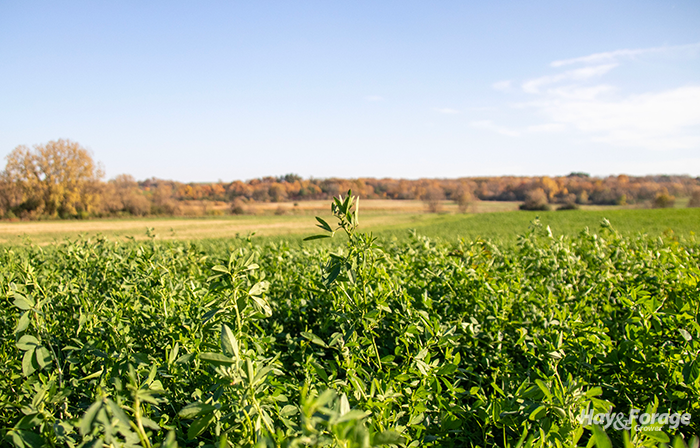Three “what-ifs” for late season alfalfa |
| By Amber Friedrichsen, Managing Editor |
|
|
 The end of the line for alfalfa growth is usually when plants experience a hard freeze. This weather event can be defined by temperatures dropping below 25ºF for more than four hours, and some regions are gearing up for their first freeze event of the season. Although many farmers have already hung their hat on the growing season, others may be considering another cutting. There are a few reasons to haul hay equipment back in the field after it freezes over for a final harvest, especially if high-quality feed supplies are low. However, in many cases, it’s more economical to ignore the itch to take a late fall cutting than to scratch it. In a recent article from Kansas State University Extension, Romulo Lollato, John Holman, and Tina Sullivan answer three “what-if” questions regarding late season alfalfa management. Overall, if plants are short or drought-stressed, it’s best to let them rest. On the other hand, if a thinning stand is due for rotation, a fall cutting might make sense. What if alfalfa is short? If plants are less than 12 inches tall, the extension specialists advise farmers to avoid taking a late fall cutting since the low tonnage would not justify harvest costs. Stand thickness is also a yield factor, but they recommend alfalfa be at least 12 to 15 inches to warrant a profitable final cut. What if I need feed? One approach to fall management of alfalfa is to cut forage six to eight weeks before a killing frost to allow adequate regrowth for winter survival. Even so, the option remains to take the final cutting after a hard freeze. At this point, it is unlikely that plants will draw upon energy reserves to facilitate regrowth, and this cutting usually provides high-quality hay. But once again, limited yields might not justify harvest costs. If feed supplies are scarce, another option is to graze alfalfa after a hard freeze. Pure alfalfa does have a high risk for causing bloat, but unless plants stay green, a killing frost can significantly reduce that risk. Of course, the safest card to play is to let forage rest, especially if alfalfa was stressed by drought during the growing season. What if the stand is thinning? Forage yield and quality will continue to decline the longer a thinning stand stays in production. Moreover, thinning alfalfa is more susceptible to weed growth and disease pressure. The specialists suggest stands with less than four to five plants per square foot are past their economically productive life and can be cut late this fall before being rotated to a different crop. A better method to determine stand density is to count stems. “More than 55 stems per square foot indicate that yields are not limited, 40 to 55 stems indicate yields are somewhat limited, and fields with less than 40 stems per square foot should be considered for rotation,” the specialists explain. To simplify counting stems, they share the “rule of hat.” The surface area of standard baseball cap, including the brim, measures approximately half a square foot. To assess stem density, throw your hat into a field and count how many stems are underneath it where it lands. Either double the stem count to estimate stems per square foot or compare the number of stems under the hat to half of the original thresholds. For example, if you count 30 stems beneath your baseball cap, consider that equal to 60 stems per square foot, or within the nonlimited yield range when that threshold is cut in half. |
